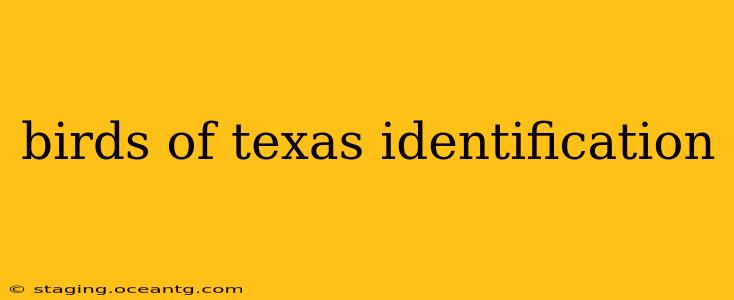Texas boasts an incredible diversity of avian life, making birdwatching a popular pastime for residents and visitors alike. Identifying these feathered friends can be a rewarding challenge, but with the right resources and knowledge, you'll be spotting and identifying birds like a pro in no time. This comprehensive guide will help you navigate the world of Texas birds, offering tips and tricks to make identification easier and more enjoyable.
What are some common Texas birds?
Texas's varied landscapes—from deserts to forests, grasslands to coastlines—support a wide range of bird species. Some of the most common birds you'll encounter include:
- Northern Cardinal: This vibrant red bird is a year-round resident, easily recognized by its crest and distinctive song.
- Mourning Dove: A ubiquitous sight across the state, this gentle dove is identified by its soft cooing and sleek grey plumage.
- American Robin: A familiar sight across North America, the American Robin is found in Texas, especially during the breeding season, with its reddish-orange breast.
- Blue Jay: Known for its boisterous calls and striking blue plumage, the Blue Jay is a common sight in wooded areas.
- Great Blue Heron: A majestic wading bird found near water bodies, it's easily identified by its size and distinctive grey-blue plumage.
- Brown Pelican: A coastal species with a distinctive pouch, the Brown Pelican is a common sight along Texas's coast.
How can I identify birds in Texas?
Effective bird identification relies on careful observation and a combination of identifying characteristics:
- Size and Shape: Is the bird small, medium, or large? What is its overall body shape—slender, stocky, or long-necked?
- Plumage: Note the bird's color, pattern, and texture. Are the colors bold or subtle? Are there any stripes, spots, or other markings? Consider variations based on age and sex.
- Behavior: How does the bird move? Does it hop, walk, or fly? What is its foraging behavior? Observing its actions can be incredibly helpful.
- Habitat: Where did you see the bird? Different species prefer different habitats. Knowing the location greatly narrows down possibilities.
- Song and Calls: Bird songs and calls are unique identifiers. Using a bird song identification app can be extremely beneficial.
What are some good resources for identifying Texas birds?
Many excellent resources are available to assist in bird identification:
- Field Guides: Invest in a good field guide specific to Texas birds. These guides often include detailed illustrations, descriptions, and range maps.
- Bird Identification Apps: Numerous apps (like Merlin Bird ID, eBird, and iNaturalist) utilize image recognition and other features to help identify birds.
- Online Resources: Websites such as the Cornell Lab of Ornithology's All About Birds provide detailed information on various bird species.
- Local Audubon Societies: Your local Audubon chapter often offers bird walks and workshops, providing opportunities to learn from experienced birders.
What are some common mistakes when identifying birds?
Even experienced birders can make mistakes. Some common pitfalls include:
- Relying on a single feature: Don't rely on just one characteristic. Consider the whole package—size, shape, color, behavior, and habitat.
- Ignoring age and sex differences: Many birds have different plumages depending on their age and sex.
- Poor lighting conditions: Difficult lighting can affect your ability to discern colors and patterns accurately.
How can I improve my bird identification skills?
Practice makes perfect! The more you observe birds, the better you'll become at identifying them. Here are some tips:
- Join a birding group: Learning alongside experienced birders provides invaluable knowledge and improves your observation skills.
- Keep a bird journal: Record your observations, including date, time, location, bird species (if known), and descriptive notes.
- Practice using identification resources: Regularly consult field guides and apps to familiarize yourself with various species.
- Be patient and persistent: Bird identification takes time and effort. Don't get discouraged if you don't identify every bird you see.
What birds migrate through Texas?
Texas serves as a crucial migratory pathway for many bird species. During spring and fall, you can see a wide variety of warblers, flycatchers, tanagers, and other migratory birds. Identifying these birds requires a keen eye and attention to detail, often utilizing the same techniques discussed previously. Knowing the migratory periods can significantly help you narrow down potential species.
By utilizing these tips and resources, you'll be well on your way to confidently identifying the diverse and fascinating birds of Texas. Happy birding!
